The RC Drift experience
COACHING HEROES
Traditional tattoos in Myanmar are all the rage
Poor man’s game: Myanmar’s grassroots golfers lead the way
Category:

Myanmar's profile on the golfing green is growing. Photo: Myanmar Golf Federation
As a hard-up 10-year-old, Aung Win scrabbled for pocket money collecting balls on a parched Myanmar golf course.
But he never thought he would one day play professionally, let alone in his isolated and impoverished homeland, where golf has long been the reserve of military top brass and the super-rich.
Now 35, he is basking in his stand-out performance at the Leopalace21 Myanmar Open in February where he was the highest finisher among the home players, winning admiration -- and a few thousand dollars.
With a purse of $750,000, the Asian Tour event was billed as the nation's richest sports tournament as Myanmar targets a new era of achievement to banish decades of junta neglect that left sport in the doldrums.
Aung Win is one of a host of poor caddies-turned-pros who are leading the way in golf, a sport that grabbed him during childhood.
He earned around five US cents a day as a caddie at the golf course where his parents both worked in his rural hometown of Monywa, near the central city of Mandalay.
At 13 he started cooking and cleaning for a local golf pro to earn his stripes before moving to Yangon a decade later.
"When I first arrived in Yangon... sometimes I had nothing to eat," he told AFP at the practice range of his Yangon golf club, where he teaches young players.
The caddie-to-player route into the game was pioneered by a clutch of international legends including Americans Byron Nelson and Ben Hogan, sons of a farmer and a blacksmith respectively.
They made ends meet as caddies during the precarious Great Depression before finding huge success as players the 1940s.
In Myanmar it remains the norm, as the country's elite generally has little interest in professional golf, leaving the field open to the men who once carried their bags.
Eight of the country's top 10 players are former bagmen, a group who are bonded together by the hardship they have shared.
"We play to beat each other, but off the field we are brothers. We all faced many difficulties to get here," Aung Win said.
- A fair way to go –
Myanmar Golf Federation chief coach Ko Ko Lay said almost all the country's professional golfers are ex-caddies.
The 80-year-old, who has trained budding golfers for over half-a-century, said the delayed graduation to the greens has its disadvantages.
"In every sport the player needs to start learning when they are young. Golf is the same. Most Myanmar golfers had no chance to play systematically when they were children," he told AFP.
But his main concern is the decrepit state of the country's fairways.
Golf was first brought to Myanmar during British colonial rule and several of the country's courses date back more than a century.
The game has an eager following among the powerful military, which has dotted the landscape with the manicured sweep of fairways, catering to troops stationed in far-flung regions.
But harsh tropical conditions and decades of poverty under junta rule have taken their toll on the ageing greens.
"Building a golf course is not very difficult, but maintaining it in the best condition is really hard," said Ko Ko Lay.
Even Myanmar's most prestigious courses fall short of international standards, he said, urging the country to follow in the footsteps of neighbouring Thailand, home to several successful players, by investing in the game.
- Making the cut –
Chan Han, head of the Myanmar Professional Golf Association, knows from personal experience the effect of Myanmar's sporting neglect.
He trained to play golf while studying in the United States along with his brother Kyi Hla Han, who is now chairman of the Asian Tour.
"When we came back to Yangon, we felt confident we could play in any tournament -- but there were no tournaments in Myanmar," Chan Han told AFP.
He ended up building his career in professional golf by moving to Malaysia in the 1980s, returning to his homeland in 1995 with a mission to revamp the game.
And finally things are looking up.
Golf earned Myanmar three silver medals at the 2013 Southeast Asian Games on home soil, which was something of a coming-out party for the nation after decades of military rule.
But Chan Han, who organised February's Myanmar Open, said there is a long way to go before the country can reach its full golfing potential.
"All sports need specialised strategies and government support. Without filling that blank, we cannot raise up any sport to world-class standards," he said.
Aung Win was the only Myanmar player to make the cut to the final rounds at the February tournament, finishing tied for 54th place.
Even if international stardom eludes him, he wants to help boost the chances of the next generation.
"I want to be a good coach for the future of Myanmar golf," he said.
© AFP
Myanmar’s ‘long-necked’ women hope to turn tourism into homecoming
Category:
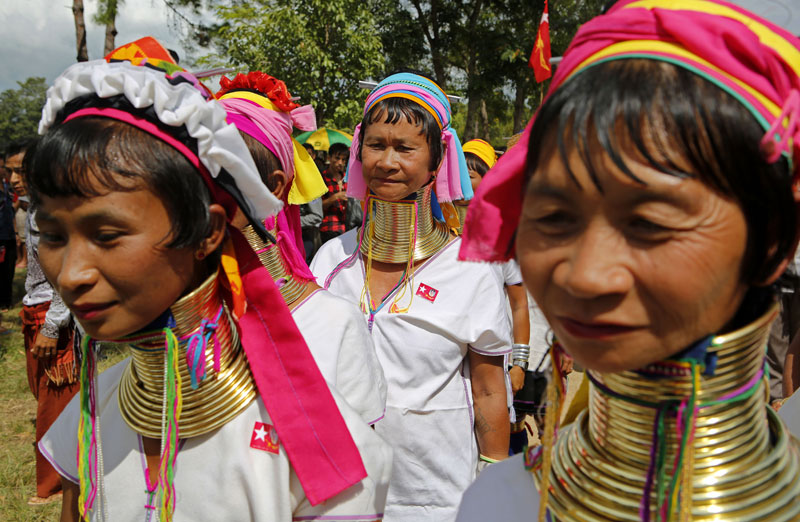
Padaung ethnic women arrive to listen to a speech byMyanmar opposition leader Aung San Suu Kyi during her first official election campaign at Demoso township Kayah State, eastern Myanmar, 10 September 2015. Photo: Lynn Bo Bo/EPA
Wearing a stack of bronze neck coils -- a sign of beauty for her Kayan tribe -- Mu Par dreams of a time when all "long-necked" women can return to Myanmar from Thailand where they are a tourist attraction.
For years Kayan women and girls have been driven across the border by poverty and conflict to earn money posing in holidaymakers' pictures in purpose-built Thai villages decried by rights campaigners as "human zoos".
Now several have returned to their remote native Panpet area in Kayah state, Myanmar, with an entrepreneurial plan to reverse the flow of departures as their once junta-ruled homeland emerges from decades of solitude.
Mu Par came home just a few months ago having saved enough money after 14 years working in Thailand.
She now runs one of a dozen neat little shacks selling locally-made wooden dolls, scarves and individual bronze neck rings -- giving tourists a more ethical window into their unique culture.
Lining up a neat row of handmade "long-neck dolls" at a new craft market, Mu Par hopes to entice tourists to her eastern Myanmar homeland, and provide for her four children, aged between four and 15.
"In Myanmar my children can attend school and also I am happy to be among my relatives," the 33-year-old told AFP, as a handful of tourists milled through the area.
Once the preserve of intrepid travellers as it languished under junta rule, Myanmar is now a hot new tourist draw.
Arrivals have doubled in the past five years and numbers are expected to surge under a new government led by Aung San Suu Kyi's pro-democracy party.
Much of tiny Kayah state was off limits to foreigners until recently.
Authorities now hope the region's emerald hills and languid waterways will become the country's next top travel destination.
Mu Par and her neighbours from Panpet's cluster of five hamlets grouped together to build the market.
They share the profits from the 5,000 kyat ($4) visitor entrance fee.
"If we can get many tourists here, we want all the Kayan girls in Thailand to come back," she told AFP.
- Controversy and culture –
From as young as five years old, Kayan girls are given up to ten neck rings to wear, they then add a new one approximately every year until adulthood.
The practice, which gives them a giraffe-like appearance, painfully compresses their shoulders and collarbones, rather than actually stretching their necks.
A grown woman can wear as many as 25 rings, weighing a total of five kilos (11 pounds).
One local legend suggests women began wearing the rings to protect themselves against tigers, who once roamed the region in large numbers and bite the necks of their prey.
Men in the village also used to wear face-shaped masks on the backs of their heads in a bid to ward off tiger ambushes, according to local people, although the practice has since died out.
Fewer women now wear the coils, which force them to keep looking straight ahead.
Families often cannot afford the costly, handcrafted rings, while many young girls feel they are an impediment to getting a job outside of their region.
The women can remove their rings with the help of a specialist and their shoulders and collarbones can eventually return to normal, depending on the age when they are taken off.
Several dozen women and girls still wear the traditional bands, including those at the new handicraft market in Panpet.
Until recently they spent much of the year in Thailand, earning around 3,000 baht ($90) a month in the tourist attraction villages, where most of the money goes to Thai tour agents.
"Asking them to pose for photographs for money is acting like they are in a human zoo," said Phyoe Wai YarZar a Myanmar tourism official.
"Instead (in their home villages) people can buy their products like food, handmade crafts and souvenirs to support them."
© AFP
Capturing the sights of disappearing Yangon
Category:
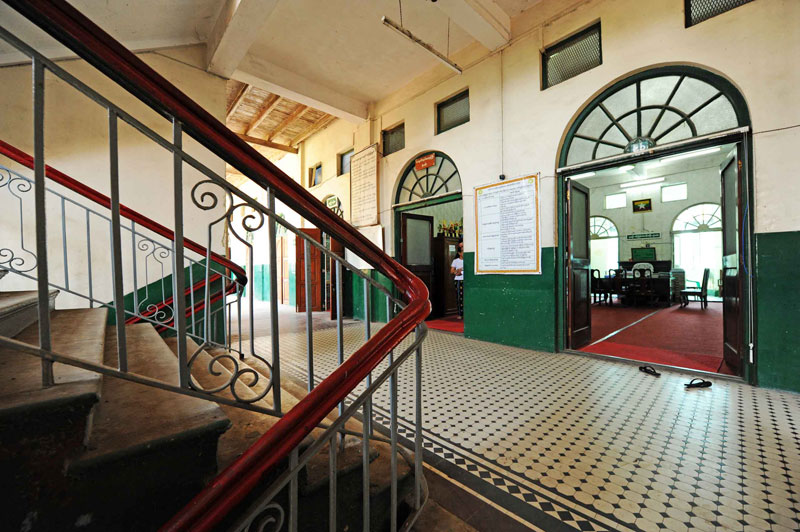
BEHS 6 Botataung. Photo: Philip Heijmans
After two years in the works, “Relics of Rangoon” - a photo and research book covering 200 of Yangon's most prominent heritage buildings- is ready for its official launch at the beginning of May.
The book is the work of journalist and photographer Philip Heijmans, the culmination of over two years of research with a team of researchers, over 8,000 photographs, hundreds of hours of interviews with custodians, trustees, government officials, custodians, architects and conservation experts, and documentation research in the Myanmar National Archives.
Relics of Rangoon is a luxury photo book profiling Yangon's heritage buildings in a bid to protect it from degradation and disappearance. The book is over 360 pages long and at 10 x 12 inches is printed in hardcover.
The official launch will be held at Pansuriya Gallery on Bogolay Zay Road at 7:00PM on May 4.
"Relics of Rangoon is a magnificent tribute to this jewel of a city, past, present and future. The product of the loving eyes, dedication, and prolonged exertions of a team led by Philip Heijmans, This book is a monument to be treasured," writes Sean Turnell, Associate Professor, Department of Economics at Macquarie University and Economic Advisor to Aung San Suu Kyi's National League for Democracy Party.
“This beautiful book will be an eye-opener. The excellence of Philip Heijmans’ photographs and his concise but thoroughly researched accounts will appeal to tourists and scholars alike. Rangoon was, for me, ‘love at first sight’ and I will treasure Philip’s book,”Dr. James Simpson OBE FRIAS, Simpson & Brown Architects.
In the following interview with Mizzima, Mr Heijmans explains the passion behind his project.
What got you interested in this project?
When I moved to Yangon in 2013 as business editor at The Myanmar Times, we were doing quite a few stories dealing with Yangon's heritage and they were always fascinating. It became quickly apparent that this was going to be the defining aspect of this city that could make or break its appeal in general. I had sought out materials to learn more about Yangon's colonial past and about the buildings themselves, but there was little and so I thought it would be cool to do a book that covered the topic comprehensively, featuring pictures of both the interior and facades of the buildings. But months later, I realized that the project made no sense without the accompaniment of historical research for each of the buildings, and so I kind of had to start over with my researchers.
I think what triggered all of this though was a subconscious desire to get more involved in the topic of architecture. Earlier, I had spent four years in Prague, where half of my family are from, and I fell in love with it. My mother dabbled in architecture as a hobby and that had probably passed on to me in some way.
You came from Prague to Yangon - how did that come about? What drew you to Myanmar?
I wish there was a more sexy story in here but the truth was that at the time I decided to move to Southeast Asia in 2010 from Prague I was struggling as a first-year journalist in a market that draws very little international interest. I saw an opening at a newspaper in Phnom Penh called The Cambodia Daily and just went for it. I had never been to SE Asia and had no idea what I was walking into, but I'm really glad I did it. Over the next three years in Cambodia, we journos always kept an eye on Myanmar and it was always in the back of our minds. Then in early 2013, my current fiance and I were living in Taipei when the firm I was working for twice sent me to Yangon on business, and I immediately knew this is where I had to be.
Your project seeks to cherish these old places in Rangoon. Is there a danger that much of what you cherish here could be lost in your lifetime as Rangoon is developed?
I think I can say with relative certainty that at least some of the places featured in the book will not be around for much longer. Since 1990, some 1,500 buildings in downtown Yangon have been torn down and though the pace of that has slowed dramatically, it has by no means halted. Take the Kyaikkasan Horse Racetrack for example, or Gandhi Hall, two places with a wealth of history that helped define this city's past, and in both cases there has been one proposal after another to tear them down. It's disgusting.
More information can be found on Facebook at: https://www.facebook.com/relicsofrangoon/
Keeping a Chin tradition alive by bringing it online
Category:
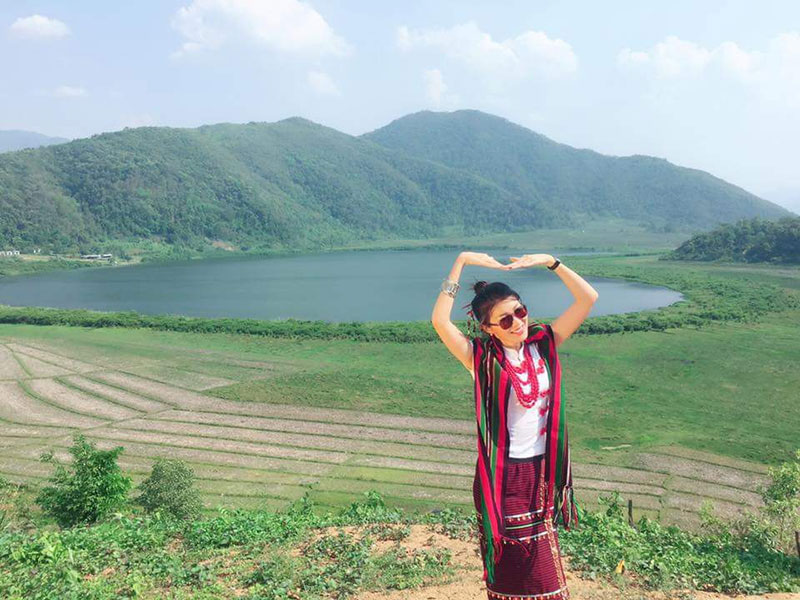
Miss Universe in Chin State - showing off the fabrics. Photo: Moe Sat Wine/Facebook
Twenty-eight-year-old Cing Zeel Niang was born in Chin State but left home at an early age to attend boarding school in Pyin Oo Lwin and later studied medicine in Mandalay. Her parents felt that it was in their daughter’s best interests to be educated outside her home state, as standards are lower than in other parts of the country. Chin State lacks a single university - the closest is in neighbouring Sagaing Region – and it is the most underdeveloped nationwide in terms of infrastructure. Cing Zeel Niang - Rosy - graduated in 2012 and began working at a private hospital, but had long had plans to start a business in a completely different walk of life and one that was closer to her roots – selling Chin textiles online via Facebook.
“I hadn’t seen anyone try do it,” she told Mizzima Weekly.
Rosy explained that selling via Facebook is more practical than setting up a dedicated website, as slow internet speeds would make page loading difficult and frustrate potential customers.
However, Rosy was daunted by her lack of first-hand experience in running a business.
“No one in my family has any business experience and they weren’t at all familiar with online businesses. So I didn’t have any business knowledge passed down to me.”
In 2014, Rosy leapt at the chance to take part in a start-up business course with the social enterprise Project Hub Yangon (PHY). The six-month course was the first to exclusively target female entrepreneurs in Myanmar.
“The incubation programme gave me the skills to refine my business idea. If I didn’t take part in it, I don’t think I would have started my business,” she said.
Like many people in Myanmar, where bank loans are virtually unobtainable without collateral, Rosy lacked funding to back her bright idea. Fortunately, the knowledge she acquired through PHY’s programme helped her to develop creative solutions to counter financial constraints, which is an integral part of start-up business methodology.
While still working at the hospital, Rosy began selling Chin fabrics for a handful of Chin women. She photographed the fabrics and uploaded them to her Facebook page, Rosy’s Chin Fabrics, so that she received orders instead of speculatively purchasing anything.
“I also used my colleagues at the hospital, 99 percent of whom were female, to do market research. They were all interested in Chin fabrics and I got to know the price range they were willing to spend.”
She also quickly discovered that Myanmar women are eager to wear fabrics belongings to a different ethnicity.
“Bamar women have no problem wearing different fabrics. If the price is right, they actually prefer to wear tribal fabrics because it makes them stand out,” she explained.
Once she had a sizeable number of orders, Rosy began travelling to Chin State to source the fabrics.
However Rosy’s parents were dismayed to learn that their daughter planned to launch an online business rather than continuing her work as a medical officer.
“My mother wanted me to have a stable, respected profession. It took me six months to convince her that I wouldn’t give up my medical career entirely and that I could balance it with my online business,” she said.
By day, Rosy runs her online business and at night she works as a medical consultant for a parenting website.
Rosy has been running her business for 18 months now and has her family’s full support. When she gave birth seven months ago, her mother volunteered to travel to Chin State to buy the fabrics.
“My mother works with my second cousin, who belongs to a group of weavers.”
However, although Rosy and her mother know a great deal about the traditions behind Chin weaving, which is considered the most intricate of any ethnicity in Myanmar and requires at least two weeks to complete a single piece, neither know how to weave.
“My mother cannot weave and I also cannot, so it’s unlikely that my daughter will learn either,” said the 28-year-old.
“The number of Chin people who know how to weave is decreasing. Women my age don’t know how to weave – those who do are my grandmother’s age, which makes it almost impossible to pass on the information.”
If the tradition of hand-weaving were to die out altogether, it would be a huge loss to a fascinating tradition. Whilst Chin fabrics have more than an ornamental role, with shawls keeping its bearers warm in one of the coolest areas of tropical Myanmar, many are rich in cultural significance. Shawls are highly specific to each of the dozen sub-groups of the Chin people and are also used to mark significant occasions, such as marriage and death. Special blankets, historically woven by the bride, are presented to a couple to mark their marriage – and cover the corpse upon death.
A red shawl, which incidentally looks very much like Scottish tartan, is given to a male who in earlier times fought and killed an enemy from another village, or killed an animal that threatened the safety of his fellow villagers. The shawl is worn during the celebrations that follow, and other men who previously received the honour also don red shawls.
Women of certain Chin tribes receive a white, green and red shawl when they get married, and wear black and white shawls during periods of mourning. Orange is a popular colour for shawls worn by Chin people (who are also sometimes referred to as Zomi) in India, which borders Chin State. Rosy’s primary market is domestic but she also ships items to the United States, where a sizeable population of Chin people live.
Rosy said that new fabric patterns are created every few months, but added that Chin weaving is becoming increasingly rare due to the lack of livelihood opportunities it offers in modern times.
“My dream and vision is to inspire young women living in villages in Chin State to know that they can still make a living out of weaving,” she said.
While machine-made alternatives exist, Rosy steers well clear of them: every item on offer is produced by a handloom.
“This is a socially responsible business – products made using a machine simply won’t work for me. When everything is done by a machine, there’s no value in it. And machines cannot do the most complex work.”
Rosy is also keen to motivate other women to start their own businesses and follow their passions.
“I have always wanted to inspire other women to start something new and to follow their dreams. Even if there is a lot of pressure and a lack of support, just keep at it and eventually you will succeed – you will get somewhere if you put enough effort in. When I started my business I didn’t get enough sleep: I had to learn online skills and it took a lot of time. But finally it’s paid off,” she said.
(Featured in Mizzima Weekly Issue 20 – To http://www.mizzima.com/subscribe )
Checkmate? Purists fight to revive Myanmar’s ancient chess
Category:
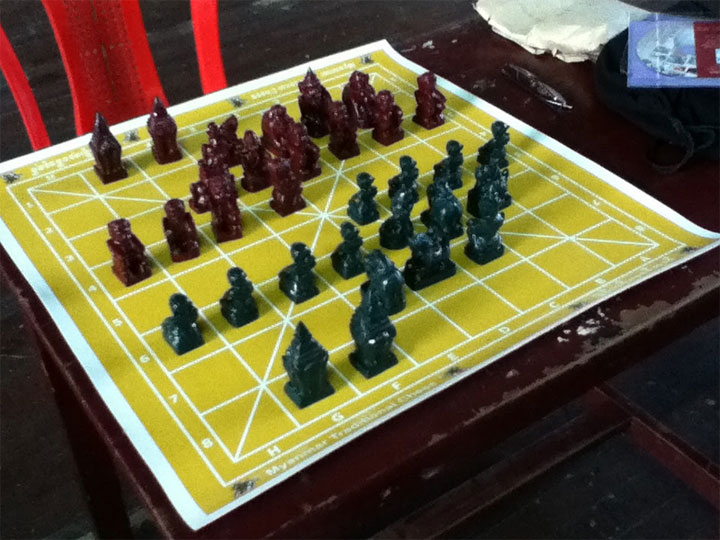
Sittuyin. Photo: Wikipedia
Gripping a monkey-faced chess piece, Thein Zaw swipes his hand across the chequerboard and topples an advancing demon, demonstrating an ancient form of the game that Myanmar traditionalists are battling to revive.
Sittuyin, as Myanmar's unique chess is called, is similar to the modern game but has distinctive pieces as well as moves that echo a time when warriors used it to fine tune real fighting strategies.
Elephants rampage across the squares, a military general marches in place of the queen and players have creative freedom to arrange many of the pieces as they wish, behind front-line pawns that start almost spear-to-chest.
"The game can feel like you are fighting a war," said Thein Zaw, a five-times Myanmar chess champion, during a recent Sittuyin contest in downtown Yangon.
His match is combative from the outset, with slain pieces quickly piling up on either side of the board.
But soon both armies become entrenched and the games reaches long into the sweltering tropical afternoon, punctuated only by exclamations, the strategic rearrangement of longyi sarongs and pensive twirling of spectacles.
The scene is a rare one in a nation where Sittuyin has retreated into the sporting wilderness.
A scarcity of traditional chess sets and dearth of available knowledge about the rules have whittled down interest, so that just under one hundred players actively attend tournaments.
"This is an ancient game and we would like to bring it back to life," Thein Zaw told AFP.
- War and pieces –
Thein Zaw's hand-carved chess set of monkeys and ogres evokes the earliest incarnations of the game in neighbouring India, playing out the mythical good-versus-evil battle of Rama and the god Hanuman against the demon king Ravana.
Experts say this suggests the Myanmar version could be over a thousand years old.
Jean-Louis Cazaux, who has written extensively on the history of chess, said Sittuyin has similarities to traditional games in Thailand and Cambodia and is an important addition to a global pantheon of chess varieties.
"Diversity is wealth. If these games can be preserved they must be preserved," he told AFP.
Sittuyin retains some of the full-blooded flamboyance from the days when kings used it to plot real battles in which elephants were a fearsome weapon -- "Sitt" in Burmese means "war".
"Myanmar kings fought in the front lines of every war. Similarly, the result of the game depends on the king being active," said Win Aung, vice chairman of the Myanmar Chess Federation.
Traditional games were peppered by the combative crack of the pieces against the wooden board.
"When my father and grandfather played it was like this," said Win Aung, slamming a pawn down onto the table. "We were scared!"
Those pieces are now a cherished heirloom, their handsome red and black elephants, castles and galloping horses smoothed by more than a century of table-top warfare.
- Chess for the masses –
Old sets are scarce in Myanmar, where five decades of brutal military rule brought both a cultural malaise and poverty that turned intricately carved wooden traditional chess sets into luxury items.
They were sold off piece by piece.
"Visitors from other countries love to buy ancient chess pieces when they come here. Myanmar sold the pieces as examples of ancient artistic creation to tourists. Now they are nearly all gone," Win Aung told AFP.
With new carved sets costing around $300 -- far beyond the reach of ordinary people in the still impoverished nation -- chess groups are modernising to chase mass appeal.
Cheap plastic pieces and a rule book, in both Burmese and English, are now on the market, and the tech-loving younger generation can play the ancient game on mobile phones -- now widely available as the country opens after decades of restrictions.
Web application firm Total Game Play launched a mobile version in late 2013 and says it has since been downloaded up to 200,000 times.
The firm's 25-year-old marketing manager Sai Pyae Phyo Han said local gamers like Sittuyin's colourful characters and the ability to switch between a "formal army, Thai army and an ogre army".
"I want to produce more mobile games that are uniquely Myanmar and make culture entertaining," he told AFP.
© AFP
Marksman guns for Myanmar’s maiden medal
Category:
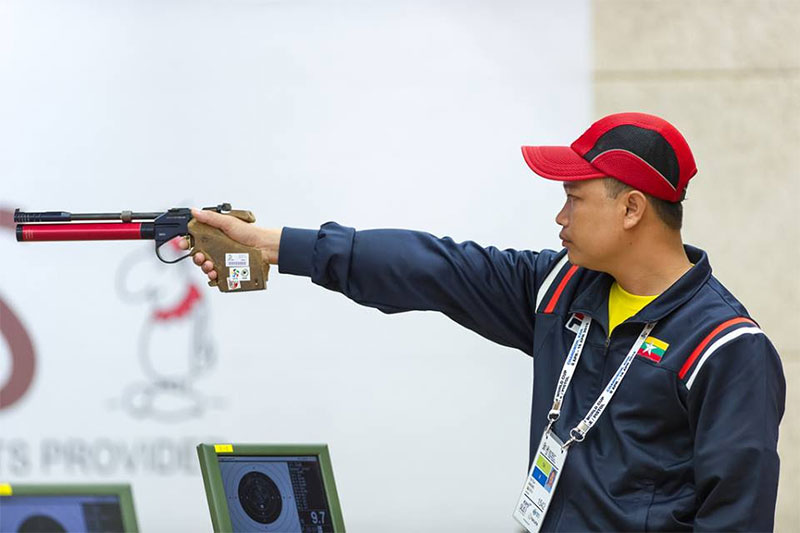
Ye Tun Naung. Photo: ASEAN Youth Organization
Standing stock-still, right arm outstretched, eyes unblinking, Myanmar's only Olympic qualifier squeezes the trigger and sends a pellet slamming into a paper target -- a skill honed during military service in the formerly junta-run nation.
Ye Tun Naung, 33, is gunning for a medal in Rio this summer, where he travels as an outside bet for a podium finish in two pistol shooting events.
A medal would be a first for his impoverished Southeast Asian nation, which was run for decades by a junta that lined its pockets while all other areas of society -- including sport -- shrivelled.
But in a twist of fortune, the junta years accidentally unlocked Ye Tun Naung's hidden talent.
He stumbled upon a knack for shooting during mandatory target practice sessions in the navy, an institution he joined to escape poverty and a lack of jobs in central Myanmar.
He first picked up a pistol in 2005, stunning more experienced military marksmen with victories at naval competitions.
Now more than a decade later sport's greatest stage beckons as he travels to the Brazilian mega city of Rio de Janeiro to compete in the 10 and 50 metre air or 'free' pistol events.
"It's not easy to have a chance to participate in the Olympic Games and it's very difficult to win a medal," he told AFP, as he carefully packed his Swiss-made pistol into its case after a practice session in a downtown Yangon shooting range.
"I am hoping for the best. But this is a sport where mentality is key to success... even the best cannot be sure how they will perform on the day," he added.
- Mind and body –
The discipline, which has been a part of the modern Olympics since its inception, sees shooters fire 60 times at long intervals.
It is sport requiring an almost meditative control of body and mind, Ye Tun Nuang explains, relying on a dead eye, perfect control of breathing and ice cold nerves.
"The decision must be certain and the mind must be stable," Ye Tun Naung explained.
"Some people meditate and some do yoga, but for me mostly I read books," said the shooter of his extra-curricular training.
"If you don't concentrate, you can't get the meaning of a book. I read to train my mind to find the concentration I need to shoot."
While six invitation spots have be gifted to Myanmar athletes, he is the only one who will represent his poor, newly emerging country on merit having qualified through a runners-up spot in a World Cup event in South Korea last year.
It will be the high point of a journey from young sailor to the Olympics that is made all the more remarkable as its originates in Myanmar.
The Southeast Asia country is one of the world's poorest nations and its sporting infrastructure was all but rubbed out by neglect under its venal and paranoid junta, which cut the country off from the world.
Before the rot set in, Myanmar was something of a regional sporting powerhouse.
The mid-1960s saw the 'golden age' for the country's football, with Myanmar adding triumphs in the 1966 and 1970 Asian Games to victory at five consecutive editions of the Southeast Asian Peninsular Games.
But the money for sports evaporated, leaving athletes, trainers and facilities to wither.
"Myanmar faced difficulties for many years and the sports sector was weak. Students for example could not practise any sport at a decent level at school," explained Sein Myo Myint, formerly a famous volleyballer and now a prominent sports journalist.
"New talented generations could not emerge," he added.
Elections last November saw the country edge out of the military's shadow with the government of Aung San Suu Kyi take over.
Sport is now creeping back into the life of the country with promises of greater investment to match a newly found national confidence.
But it will take some time for money to trickle down and until then Myanmar's sportsmen and women will have to sharpen their skills on their own.
For Ye Tun Naung that means honing his concentration -- and self-belief -- in his down time.
"People watching might think shooting is boring... but my mind is at peace when I shoot," he added.
© AFP
Dust–A health hazard for Mandalay’s marble carving industry
Category:
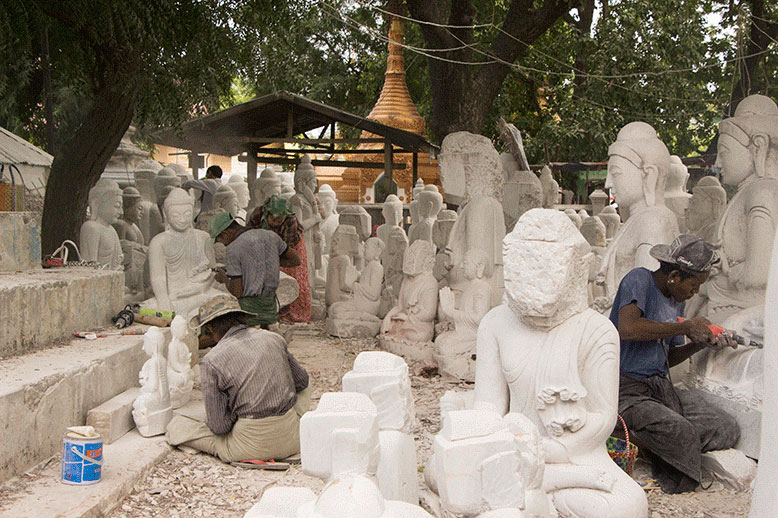
Photo: Yitsing Wang
For centuries, villagers at the foot of a hill in Mandalay region have carved a life out of stone.
About 30 km north of the former royal capital, the village called “Sagyin", which means “marble” in Myanmar, has become a large production base for more than 5,000 families.
“There are 7 hills surrounding our village. Most of the families here survive on making Buddha statues. I spent 5 years learning the craft in my childhood,” said Ko Myat Khin, who has worked in the industry for more than 13 years.
However there is a problem, most of the crafters in Sagyin don’t have the dust guards although the white dust always shrouds their face during work time.
Unlike farmers, who are at the mercy of each harvest season's ups and downs, the only thing these crafters need to care about is keeping in contact with their customers -- normally wealthy donors or dealers, occasionally there will be orders directly from temples. The business keeps villagers busy all day, sometimes even through the night. But, with continued exposure to dust in the smoke-filled environment, some crafters feel are concerned about their health.
“Some people who don’t have good immunity [to the dust] become sick,” Ko Myat Khin said. But he also admitted that he never thought about wearing dust guards or other masks, “because I haven’t seen anyone wearing them.”
Ko Myat Khin told us he specialises in carving the decorative pattern on medium Buddha statues. One statue usually takes him 4 days and he can earn 50,000 kyats.
Near his booth, many semi-finished statues are packed on a truck to ship to Mandalay. Most of them will arrive at the famous “Marble Street” in the downtown area.
Next to the Mahamuni Pagoda, “Marble Street” is the centre for Mandalay’s marble merchants. White Buddha statues are piled up at the roadside everywhere and many young drafters squat on the ground to use drills carving the patterns.
Carving workshops in the street began to thrive in the early 1990s as production increased with the help of electric tools and the number of workshops has now tripled to more than 60.
Compared to Sagyin village, the only difference is these workshops are equipped with electric fans — although they are very simple and not often turned on.
“After work, I often eat some bananas to help me purify the bronchus,” one worker said.
“Sometimes I feel concerned about my chest,” another craftsman said. But he didn’t consider this a big problem. “We are engaging in a good job, and the Buddha will bless us.” He added.
Contemporary Paribawga furniture graces 2016 Yangon Furniture Fair
Category:
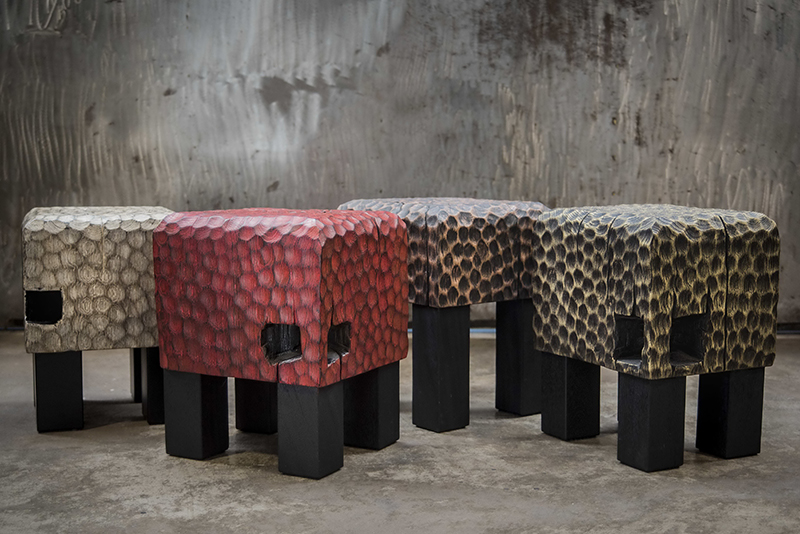
Pun + Projects, a leading hospitality, lifestyle and culture innovator in Myanmar, says it is proud to announce its new furniture concept, Paribawga, on occasion of its inclusion in the 2016 Yangon Furniture Fair. Through two channels, the Paribawga Collection and Paribawga Bespoke, the company will work with private individuals, commercial partners and interior designers to create and fit custom spaces all around the world.
The Paribawga Collection is designed and manufactured under the supervision of master carpenter Marcelo Maier, and consists of furnishings and accessories for living and working. High-quality, carefully sourced, local materials are combined with craft-based construction to reflect the history and legacy of Myanmar. Modern lines and forms lend the collection a contemporary edge, and special attention to texture and finishes evoke the moodiness of monsoon season and the lush complexity of the rainforest. A highlight of the first collection is a burnt finish, which updates traditional teak wood with a rich, smoky exterior.
Maier’s love for detail, and his commitment to finding the artistry within raw materials, defines this first collection. Says Maier: "The quality of the wood is the soul of the tree. It is a living material, and to show its beauty, you need to understand how it moves. I hope this philosophy will be reflected in every piece I create.”
In addition to the collection, Paribawga offers specialty bespoke furniture services for private individuals, companies, and designers, and employs the same careful attention to materials and craft. Paribawga aims to create custom furniture and installations for all types of spaces, including retail, hospitality, public and cultural environments, with the goal of optimizing comfort, function and style through close collaboration with the client.
Maier told Mizzima: “The Paribawga Collection consists of pieces that we have created and engineered and are ready to be selected and ordered by customers. We do have a range of finishings to choose from so there is a level of customization. Paribawga Bespoke however allows the customer to create from scratch and is 100 percent unique. This is often popular with professional designers or architects working on a specific project.”
He explained the custom-made production.
“The bespoke process usually begins with a detailed design package or a simple sketch from a client. Sometimes it might just be a series of photo images so we understand what the client is looking for. From there our technical team lead by our master carpenter Marcelo Marier will engineer the piece and produce a CAD drawing with the final dimension, technical and design details for the client's approval. The production process will then take 4-6 weeks typically,” he said.
This is a growth industry.
“With so many new projects in Myanmar both residential and commercial, we are confident that there will be increasing demand for quality furniture and accessories in the coming years. We also believe that with the access of incredible materials we have my and new technology we are in a position offer the next level of Myanmar made products,” Maier said.
Paribawga Bespoke is proud to bring Myanmar-made craftsmanship to the world at an intimate and accessible level. Says Ivan Pun, “The unique access we have to extraordinary materials and excellent craftsmanship allows us to offer a compelling product to a diverse global clientele. After years of isolation, it is an exciting time in Myanmar to show the world the level of quality in our artisan traditions, and to do it responsibly and at a reasonable price.”
Marcelo Maier has spent seven years living and working in Myanmar. A native of Bielefeld, Germany, Maier apprenticed in furniture carving and design before striking out on his own. Inspired by a passion for traditional techniques and a respect for nature, his approach integrates a love of Myanmar and a commitment to the highest quality artisanship.
PUN + PROJECTS creates innovative lifestyle, F&B, and cultural concepts in Myanmar, inspired by a passion for architecture and urban history. Founded in 2013 by Chinese-Burmese entrepreneur Ivan Pun, the company aims to facilitate cultural conversation between Myanmar and the rest of the world.
Myanmar’s storied film industry gears up for a sequel
Category:
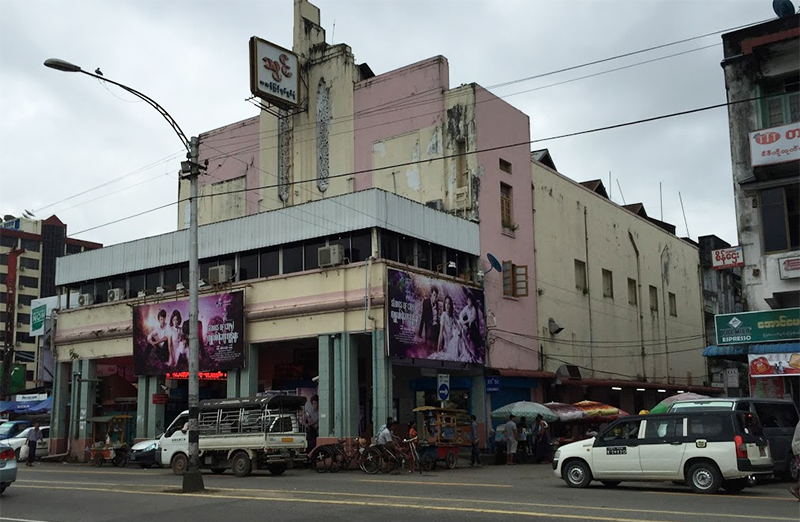
Thwin cinema. Photo: M TR/Google+
With turquoise columns propping up a pink and yellow portico, Myanmar's art deco style Thwin cinema is a rare relic from a golden age of movie-making that dazzled audiences more than half a century ago.
Myanmar's film industry, once the most vibrant and prolific in the region, shrivelled under a military regime that smothered the arts and ravaged the economy during its ruthless 50-year reign.
Now as the fledgling democracy emerges from the doldrums of junta rule, the stage is set for a film industry renaissance.
But the first step is repopulating the poor country with cinemas.
In its heyday Myanmar had nearly 400 theatres spread across its hilly terrain. Today only some 50 remain, mostly in urban Yangon.
"That is not enough for 53 million people," said Tin Maung Win, a garrulous businessman trying to bring movies back to the masses with a plan to build 100 new cinemas in two years.
The Thwin is the only theatre still selling tickets on what used to be known as Yangon's "cinema row" -- a major city artery that once boasted six movie houses.
The others have been knocked down to make room for more lucrative development, while one stately cinema dating back to the 1920s has been boarded up for years.
The dearth is even more pronounced in the rural and impoverished provinces, where theatres have all but vanished after they were sold off by the former military regime.
Tin Maung Win and his business partners were inspired to take up the "100 cinema project" after hearing about a 2012 film shot near the border with Thailand, where local actors were unable to see their work because there was no screen for miles.
"We got this idea that we needed to create cinemas all over Myanmar," he told AFP, sitting next to a model of the low-cost, one-screen theatres with 300 seats, where tickets will go for around a dollar each.
- Losing the plot –
While they will not rival the grand movie houses built during the industry's peak, the hope is that a rapid increase in theatres will inject cash into an industry where the majority of movies now go straight to DVD.
Myanmar's motion picture industry reached its acme in the 1950s -- a time when optimism was flowing after independence from Britain and before the army seized power and clung on for five decades.
Stylish stand-alone cinemas like the Thwin cropped up in towns across the country, with crowds filling their teak wood chairs to watch romances, thrillers and foreign flics.
In the country's inaugural Academy Awards ceremony in 1952, the first best picture award went to 'Chit Thet Wai', a tale of love between a city boy and a country girl who must contend with a jealous sister.
But after its 1962 power grab, the junta increasingly leaned on the industry to crank out socialist propaganda.
Scripts were vetted by censors, who issued stringent and often bizarre bans on everything from ghost stories to blue jeans in a bid to ward off foreign influence.
"The quality kept decreasing," said Mighty, a director who has been in the business since the 1980s and feels his generation was robbed of the chance to reach their creative potential.
"They intentionally made it so we did not become educated people," the 51-year-old, who only goes by one name, said of the country’s military oppressors.
"Now there is no one who knows about the art of film perfectly," he added.
- A second act? –
Censorship has eased since the end of junta rule in 2011 and horror flicks are now a box office favourite.
But many say that despite growing freedoms and improved technologies, mainstream production houses have yet to veer off script and grapple with political issues or other sensitive topics.
A class of Burmese students at the Yangon Film School responded with an emphatic "no!" when asked by AFP if they liked contemporary Myanmar movies during a break from analysing scenes of 'Taxi Driver', the 1976 American classic starring Robert De Niro.
"They (Myanmar films) are somehow good in technical skills, like colour grading, and sound design," said student MyatMinnKhant.
"What annoys me are the stories and casting. The keep making the same cheesy stories".
Myanmar's leading man Lu Min, who looks to Tom Hanks an idol, concedes that many directors still rely on tired story tropes and cost-cutting shortcuts.
But he says the desire is there to raise the bar.
"Some people are trying hard to improve our industry,” he told AFP during a break from filming his latest action thriller.
He and hundreds of other actors, producers and directors recently gathered to discuss industry reforms at a three-day forum called "Time to Change".
Many are pushing to see the government's censorship board revamped as a ratings committee that only warns viewers of racy or violent content.
Lu Min is also hoping that rebuilding the country's network of cinemas will be the launchpad.
"Our film industry depends on the quantity of theatres," he added.
© AFP
Travelling performance troupes bring traditional shows to Myanmar communities
Category:
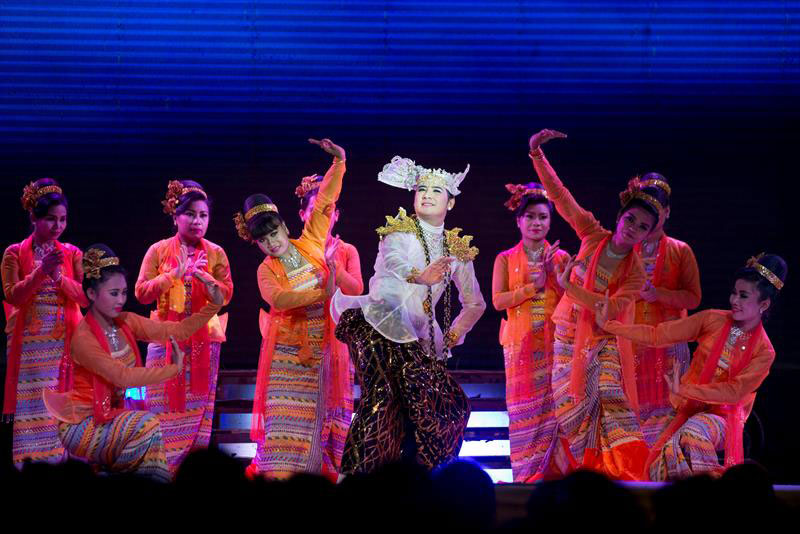
Hanzar Moe Win, 33, one of male leading dancers of San Pya Thabin troupe, performs Duet Dance, so called Nha-par-thwar, at Kyauktawgyee pagoda festival in Mandalay, central Myanmar, 22 October 2016. Photo: Lynn Bo Bo/EPA
Across Myanmar, in big cities and small towns, the performing Zat Pwe troupes crisscross the country bringing music, comedy, dance and theatre to crowds of adoring fans.
The troupes are following a tradition that began in the 19th century of Burmese theatrical performances.
San Pya Thabin is one of the most famous troupes in the country. Having started more than 50 years ago, it now numbers 85 performers.
The troupe is led by three siblings; two brothers, Hanzar Moe Win, Aggar Moe Win; and one sister, Tinzar Moe Win.
They are the grandchildren of the troupe's founder and then leading male dancer. It was later taken over by their father who became the famous dancer Moe Win, and now the brothers and sister continue the legacy.
The performance troupe started with Burmese traditional dance, but this changed after the 1988 uprising when the military junta cracked down on freedoms, according to Hanzar, 33, who recently passed his leading role onto his younger brother, 28-year-old Aggar.
 | |
| People gather in front of the main entrance of SanPya Thabin Theater before the show start at Kyauktawgyee pagoda festival in Mandalay, central Myanmar, 19 October 2016. Photo: Lynn Bo Bo/EPA |
"The military regime did not want large gatherings of people after the 1988 protests against the political regime, so our troupes mostly focused on rural communities," he told epa.
Due to the lack of electricity and transportation for rural audiences, many people travelled large distances on foot to attend the shows.
San Pya and other troupes performed through the night, with shows typically starting at 10 pm and finishing at 6 or 7 am, allowing the audience to be entertained all night and then be able to return to their homes in the safety of daylight.
The additional time for the show gave them space to add more variety to their act, so they branched out into modern music, singing, opera and comedy, while dances and traditional orchestras also entertained the audiences.
The most important part of Zat Pwe - which means 'story show' in Burmese language - remains the Duet Dance, or Nha-par-thwar, in which the male leading dancer performs a traditional dance with one or more female dancers.
 |
| A man plays drums inside circular frame during SanPya Thabin performance at Kyauktawgyee pagoda festival in Mandalay, central Myanmar, 21 October 2016. Photo: Lynn Bo Bo/EPA |
San Pya, Phoe Chit and Swan theaters are still the three biggest among several Zat Pwe troupes in Myanmar.
They travel with troupes of about 100 people for at least 10 months of the year, performing an average of 150 to 160 nights annually.
"Some people say that we are like gypsies, indeed we only stop performing two months in every year and travel and perform the rest of year," said Tinzar, 35.
"Even the time we stop in rainy season, we practice for the upcoming year," she added.
‘It’s like freedom’: Myanmar heavy metal crashes into the open
Category:

Last Days of Beethoven band plays on stage. Photo: Last Days Of Beethoven/Facebook
Moshing and sweating, the crowd of headbangers scream their angst into the sultry Yangon night, a rare glimpse of a defiant musical subculture now crashing into the open -- though sex, drugs and religion remain off the song sheet.
Half a century of repressive military rule virtually silenced Myanmar's heavy metal scene and today its musicians are still shunned by most people in the conservative Buddhist country.
But a growing coterie of die-hard metal-heads say the aggressive, rasping music gives them a unique release in a nation still struggling to come to terms with its own dark history.
"Listening to metal is the fucking best feeling. It is like freedom, it's good for the soul," 21-year-old mobile phone repairman Thaw Di Yoo told AFP at a recent gig.
"It's different from other music, that's why I am only a fan of metal," he said, showing a tattoo depicting the logo of his local heroes -- Nightmare Metal Band -- on his arm.
For A Phyu Yaung, a 30-year-old marketing manager, metal helps her escape everyday life.
"I mostly listen to metal songs when I feel stressed," she said. "It can help chill me out when I'm feeling like that."
For years metal bands were muzzled by strict censorship laws and dissident musicians were jailed and often tortured for supporting the opposition.
Banned music was smuggled in on tapes and CDs and an underground scene of punks and headbangers began to grow up out of sight of Myanmar's notorious police in the 90s.
Today the arts are flourishing, but metal music is still sidelined in a country where most prefer sickly sweet pop, crooning love songs or Burmese covers of Western hip hop tracks.
- 'Write against violence' -
Like repressive socialist regimes in Eastern Europe and Russia, Myanmar's junta feared the anarchist energy of heavy metal music.
Censors banned anything they thought could prove a spark for revolution -- from too much red or black in artworks to the mention of roses in songs, seen as a reference to democracy icon Aung San Suu Kyi.
While underground metal musicians managed to stay out of jails, their jarring sound and brooding political lyrics were publicly silenced.
"Metal is not the type of music that goes on about how much I love you and how much I miss you," guitar instructor Myo Min Thu told AFP in his teaching room, plastered with posters of US bands like Iron Cross and Metallica.
"We could not criticize Christianity or be anti-Buddhist. Politics was the worst at that time and we faced a lot of difficulties about lyrics."
Myanmar officially abolished censorship in 2012, the year after the junta handed power to a quasi-civilian regime.
Freedom of expression blossomed and many musicians came out in support of Suu Kyi's NLD party as it campaigned for last year's election, the first free vote in a generation.
Today Myanmar's heavy metal bands are still too coy to touch on topics like sex and death considered taboo in conservative Myanmar -- in stark contrast to their peers in the West.
Instead, they are using their new-found freedom to push for social and political change.
"In our new album, we mostly write about politics and the situation in the country," said Last Days of Beethoven guitarist Phoe Zaw, 32.
"We write against... violence against Muslim people and Buddhist people in Rakhine state, violence against ethnic people in (other) states."
- Social media explosion -
Still, hardcore metal remains a niche genre.
While the number of bands has grown since the end of junta rule, there are still only a few dozen in Yangon and a handful in the rest of the country of more than 50 million.
Not many venues will put on metal gigs and bands struggle to find sponsors who will pay for the high-level sound systems they need, while few shops stock the rare albums that make it onto labels.
"There are only a few shows here. I can count on my fingers the number of shows in a year," said Phoe Zaw.
"Very few people (organisers) want to hold underground shows, metal shows."
But bands say the explosion of social media over the past few years has helped to bring them into the limelight.
Now they post their music online instead of handing out CDs in teashops and on the street, and fans can share songs without having to wait for them to be formally released.
For musicians who have struggled for years to be heard, the online revolution is offering a new hope.
"I think metal music is becoming more popular in Myanmar now," said Aung Myo Linn, from Nightmare Metal Band.
"Technology and the Internet is helping as we can share songs through social media like Facebook, YouTube and others, even if we cannot produce albums."
© AFP
Night of Italian opera seen as good way to build Myanmar relations
Category:
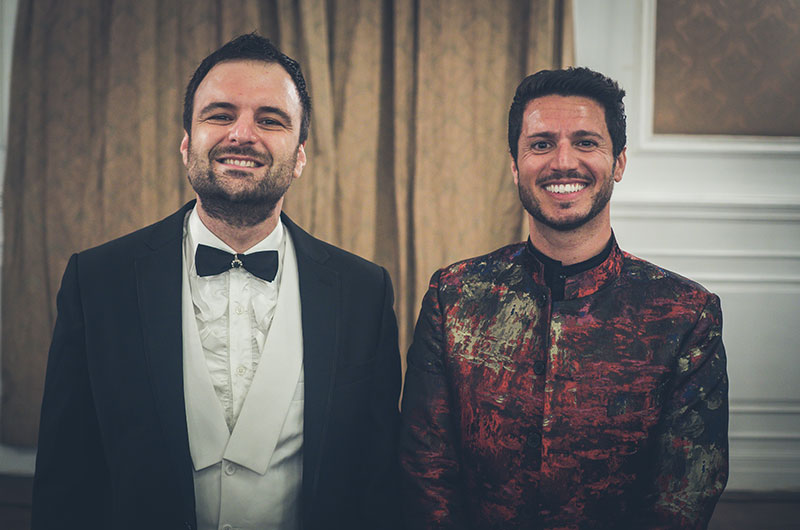
The Italian embassy’s night of opera, held at Yangon’s Strand Hotel this week, was a key part of their unique soft power approach to building good relations with Myanmar, the Italian ambassador said at the event.
Pier Giorgio Aliberti, Italy’s top diplomat in Myanmar since June 2015, emphasised the importance of creating a cultural connection between the two countries, saying “Culture is a bridge for us, and the cultural aspect is very important.”
Italy, a member of the G7 and the 8th largest economy in the world by nominal GDP, as determined by the International Monetary Fund, is poised to increase investment and trade in Myanmar’s liberalising market. However, as of 2015, it ranked 14th among Myanmar’s trade partners, and total trade between the two countries actually decreased from 2014, according to the Italian Foreign Affairs Ministry website. One of the ways Italy hopes to expand its economic and political ties with Myanmar is through culture.
The event held on December 10, titled “I Love Opera: Second Edition”, was part of the embassy’s “Italy in Myanmar 2016” initiative, which organised several cultural events in Yangon throughout the year to increase Myanmar’s exposure to Italy’s rich heritage. These include film screenings, cooking classes, a fashion show, concerts, and Saturday evening’s opera event.
Tenor Roberto Cresca and pianist Gianfranco Pappalardo Fiumara treated the assembled guests to a 90-minute set, performing pieces by Leoncavallo, Puccini, and Schubert. “Opera is traditional Italian music - it is the music of language and love,” said Matteo D’Alonzo, the Deputy Head of Mission at the Italian embassy. He added that music is universal, allowing the people of Myanmar to “see our common ground.”
Italy’s emphasis on culture goes beyond hosting concerts and showcases for its own heritage, though, as it brings its considerable expertise in helping to preserve Myanmar’s culture and history. Aliberti drew comparisons between Myanmar’s pagodas and Italy’s churches when talking about the need to protect and restore historical sites, pointing out that Italy has the highest number of UNESCO World Heritage Cultural Sites in the world.
The designation of the Pyu Ancient Cities site in 2014 as the first and only UNESCO World Heritage Site in Myanmar came about through Italy’s funding and support of the “Capacity Building to Safeguard Cultural Heritage in Myanmar” program. The program was a collaborative effort between Italy and the Myanmar Ministry of Culture, and it demonstrates the kind of relationship Italy is aiming for between the two countries.
“We don’t want to come here to tell them what to do. We take a peaceful, cooperative approach,” said D’Alonzo. High-profile visits by Paolo Gentiloni, the Italian Minister of Foreign Affairs, soon after the installation of the new government, and delegations from Italian parliament this year demonstrated Italy’s commitment to Myanmar, he added.
On the commercial side of things, Italy is well positioned to invest in Myanmar’s increasingly open markets. D’Alonzo listed construction, infrastructure, electricity, hydro, development, and sustainable tourism in particular as industries that play into Italy’s strengths. However, he said that Italy is committed to working with the Myanmar government in determining investment priorities. “The Italian approach is all about one word – respect,” he said.
After the event, Aye Kaong Zaw, an audience member, said that the performances were quite amazing, adding, “It was something like classic Burmese music, deep down in our culture.” Min Nay Thway Aung, another guest, said that, while he couldn’t understand the lyrics, he could feel what the music was about. They both agreed that the event was unique and different, and they appreciated it because it is hard for them to get to know Italian opera.
Responses like these are music to the Italians’ ears, showing the potential for the future of Italy-Myanmar relations. D’Alonzo, however, was quick to point out Italy’s positive relationship with Myanmar in the past. “We never left,” he said, explaining that the Italian embassy has always remained open, even as other countries’ embassies closed their doors. He added, “We have always believed in Myanmar.”
Seeking out the ‘hidden’ Chinese language classes in Chinatown
Category:
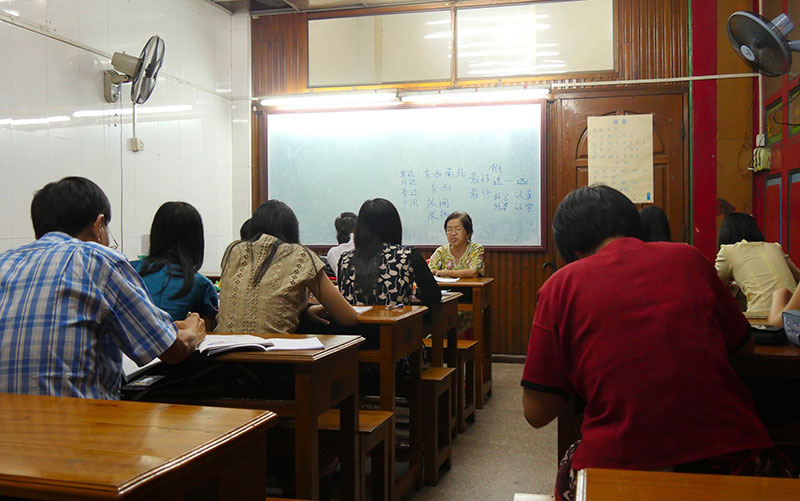
One classroom of Kheng Hock Keong Chinese language school. Photo: Yizhen Jia
Located in the centre of downtown, Chinatown is one of the busiest areas of Yangon. Walking along Sint Oh Dan Street, there is a four-storey building owned by the Fukienese Association in Myanmar with a doorplate “Fuxing Confucius Classroom of Myanmar-Chinese Language Training Centre”.
Yan Naing Lin, a 13-year-old student in Basic Education High School, No. (1) Latha, has studied Chinese after class in the Fuxing Confucius Classroom of Myanmar for three years. As he said in fluent Chinese, he is a Myanmar-Chinese and his ancestral home is Yunnan, a southwest province of China. “I come here to learn Chinese because I like it,” he said, “My parents also ask me to learn and we often communicate with each other in Chinese at home.”
In addition to Myanmar-Chinese students, there are also many Myanmar and Indians learning Chinese here, Luo Jianping, the president of Fuxing Confucius Classroom of Myanmar said. “Now the number of registered students are up to nearly 600 and there are over 30 classes here,” Luo added, “Not only children but also adults who are working come to learn Chinese.” However, Chinese-language education in Myanmar once experienced a long period of neglect, he said.
In the 1960s, Ne Win’s government banned Chinese-language education in Myanmar and all schools were nationalized, including Chinese language schools. From then on, only English and Burmese could be taught, which meant that two or three generations’ Chinese was bad,Luo said. Though the situation gradually eased after the 1980s, opening Chinese language schools publicly was not allowed. Even in 2002, when this Chinese language training centre was established with the help of the Fukienese Association in Myanmar and the Office of Chinese Language Council International(Hanban), it was named as “Fuxing Language and Computer School” rather than “Chinese language school”.
“We applied to the government for the school in the name of teaching computer and languages, but actually we mainly taught Chinese,”Luo said.
Fuxing’s situation is not an isolated case. Back to the 1980s, many Chinese temples established Mandarin classes in the name of “teaching Buddhism”. Kheng Hock Keong Temple is one of them, which is at the end of Sint Oh Dan Street, just about 300 metres away from Fuxing Confucius Classroom of Myanmar. “It was the first Chinese language school in Yangon, which was established in 1986,”said by Kyi Win, the managing director and former principal of Kheng Hock Keong Chinese language school. Win said as one of the Chinese immigrants, he had responsibility to launch such a school to encourage teaching of the Chinese language. “At first we used the Buddhist textbooks from Singapore while now we are using Chinese textbooks presented by the Chinese Embassy,” he added, “All the courses and textbooks are free and we only charge 3,000 Kyats per four months as registry fee.”
There are 13 teachers in Kheng Hock Keong, Kyi Win said, and most of them are Myanmar-Chinese.
Khin Khin Ayc, who is in her 70s, has been teaching Chinese for nearly 30 years in Kheng Hock Keong. She said she was born in Myanmar and learned Chinese from an early Chinese language school. She has two adult classes every weekday night, teaching basic to advanced classes. She said the adult students usually come to learn Chinese after work, and some of them even have no time to have dinner. “They are all very diligent,” she said. Eleven adult could be observed recently attending her mid-level class, reading aloud and taking notes carefully in a 40 square-metre classroom with 20 tables and benches. Myat Thida Soe Kyaw is another teacher who has been working here for about one year. Different from Khin Khin Ayc, Myat Thida Soe Kyaw was once a student of Kheng Hock Keong and learned Chinese here.She now teaches both children’s classes and adult classes. “It’s like a kind of contribution to my alma mater,” she said.
Unlike teachers in Kheng Hock Keong, most teachers in Fuxing Confucius Classroom of Myanmar are volunteers coming from China. Mu Longzhen is one of eight native Chinese teachers in Fuxing. After graduating from university, she volunteered to teach Chinese in Mongolia for one year, and then she was recommended to teach Chinese in Myanmar from August 2015, Mu said. In addition to basic classes and advanced classes, Mu also teaches Business Chinese classes.She said terms in Business Chinese class were quite professional and students attending this class probably had ambitions to get involved in Sino-Myanmar economic cooperation. “One of my students has a Chinese boss,” she said.
With more and more Chinese companies and Chinese tourists in Myanmar, speaking Chinese is beneficial in getting jobs, Kyi Win said, “Many students become Chinese translators, staff in Chinese companies, tour guides and so on.” President Luo Jianping also said, “If you can only speak Burmese, your monthly salary is about 100,000 Kyat. But if you can also speak Chinese, it is likely your salary will be doubled or even be 400,000 to 500,000 Kyat (per month).”Students of Fuxing also had chance to work in the Chinese Embassy only if they passed the Chinese Proficiency Test (HSK) Level 4, Luo added. After getting more knowledge of China when working in the embassy, many of them would apply for universities in China to further their study. “It is the spring of Chinese education in southern Myanmar,” Mu Longzhen said, there is a huge market for Chinese language education now.
However, there are also some difficulties. Both Fuxing Confucius Classroom of Myanmar and Kheng Hock Keong Chinese language school face a loss of students. Mu said since Fuxing only charged 5,000 Kyats per month which had charitable nature, many students didn’t have high expectations and motivation to learn continuously. “At the beginning, there were over 30 students in a class while three years later, students reduced by more than 50 percent,” Luo added, “Since students learn Chinese here for interest, we cannot make it compulsory.”Kyi Win also said that there was loss of students in Kheng Hock Keong. A report of Chinese language education in Myanmar indicated that though there are more and more Chinese language training centres, Chinese language education is still excluded from the education system of Myanmar, having some time conflicts with courses in nationalized schools, which might lead to loss of students.
Besides, the report indicated that it was the suspension of Chinese language education decades ago that led to a lack of professional teachers nowadays. Kyi Win said the knowledge of teachers in Kheng Hock Keong was limited and some teachers taught as well as learned by themselves. Though teachers in Fuxing were more professional, they didn’t have enough classrooms, Mu said.
Young b-boys look to the internet for inspiration
Category:
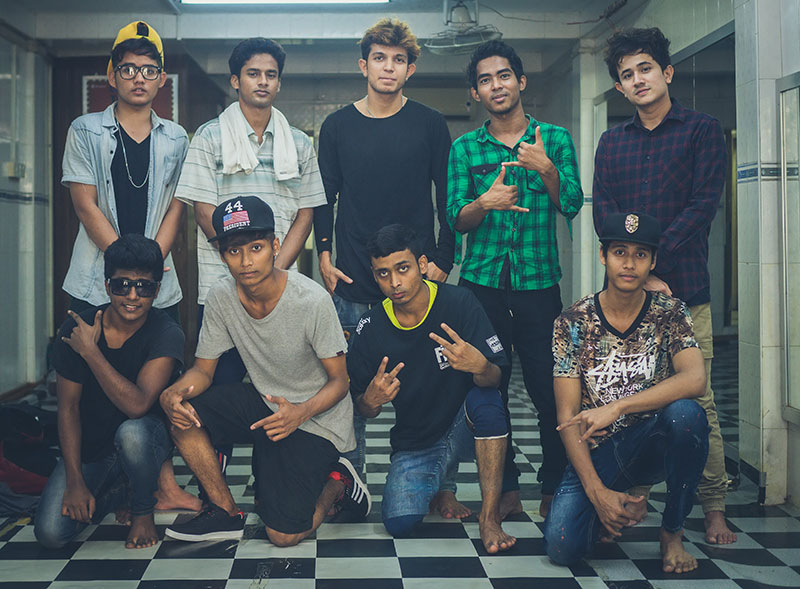
“YouTube is the best teacher,” Kyaw Myint said, while sitting cross-legged on the linoleum floor of his b-boy group’s dance studio in Yangon’s Kan Taw Ka Lay Ward.
Kyaw Myint and his group, known as B Crew, credit the liberation of the telecommunications industry in Myanmar in 2014 with the growth of hip hop culture and b-boying in the country, making online resources, such as YouTube, widely and cheaply available among urban youth.
B Crew, like other upstart groups of b-boys and b-girls in Yangon, got their first taste of hip hop culture from scouring roadside DVD stalls for recordings of international dance competitions. Attracted to some of the more physical dance moves, such as flares and windmills, Kyaw Myint and his friends, including the founder of B Crew, Ko Phyo, began imitating the dances on their own.
They soon turned to the Internet in their thirst for more dance videos, renting out computers at local cyber cafes one hour at a time. The process was painstaking and expensive. “There are no words to describe how slow the Internet was,” Kyaw Myint said, adding that paying for online access took up almost all of their allowance as students.
Everything changed in 2014, however, when Telenor and Ooredoo began their telecommunications services in Myanmar. With the advent of affordable smartphones, cheap SIM cards, and faster data packages, the b-boys could download videos quickly and cheaply, and without having to be at a specific location.
“All of us have smartphones now,” Kyaw Myint said, and several of them quickly demonstrated by pulling out their devices and loading dance videos on their screens.
The explosive growth of the telecommunications industry in Myanmar since 2014 is almost unprecedented. In a report published in 2016, Roland Berger, the German consulting firm that assisted the Myanmar government in the telecommunications tendering process, said “within a few years, mobile penetration rates skyrocketed from 7 percent of the population to more than 90 percent.”
One result of this rapid increase in Internet access was that people in Myanmar could now seek out and find online resources that had previously come at a much higher cost. For those whose passions were largely kept underground and out of the mainstream, such as B Crew and other hip hop enthusiasts, it was a godsend.
The Internet and social media platforms, especially Facebook, has also allowed dancers and groups to find and connect with one another, as well as promote themselves and their art form to a wider audience.
“We upload everything,” Kyaw Myint said, and to positive effect. Mainstream awareness and acceptance of b-boying has grown in recent years, with regular contests and performances in malls and other public spaces on special occasions.
Still, the members of B Crew feel that much more could be done to support dancers here, bemoaning the lack of resources and strategy in promoting the art.
“India started after us, but they have more support and now they have surpassed us,” Kyaw Myint said. He added that b-boys in Myanmar feel neglected and ignored by much of the international b-boy scene as well, saying, “International b-boys don’t come to Myanmar and do workshops, like for other countries.”
As of now, the odds of a career as a b-boy in Myanmar are slim to none, and Kyaw Myint and the other group members all have other jobs, such as taxi driver, teacher, baker, plumber, and electrician, though the youngest member is still a student in high school. They also offer dance classes in their rented studio in the evenings.
Ko Phyo the founder and leader of the group, said, given the limited career options available, they did not have any explicit goals for the future. “We just want to pursue our passions to the best of our ability.” Others, like Kyaw Myint, are being encouraged by family members to consider switching to a more pragmatic career path, including education abroad.
He is not opposed to that option, though he has different ideas of what he will gain when he leaves Myanmar. “I will use that time to learn from international b-boys and bring it back to my crew,” Kyaw Myint said.
His devotion to the B Crew is understandable. After years of teaching each other through grainy DVDs and slow-loading YouTube videos, practicing tirelessly in living rooms and parks across Yangon, and now witnessing the gradual acceptance and growth of b-boying, Kyaw Myint and the B Crew share a special bond.
Kyaw Myint summed it up simply, saying, “We are a family.”
Myanmar’s tourism industry shows promise but has a long way to go
Category:

Ballooning over Bagan. Photo: Elsie Chen
Floating in a balloon above the serene temples of Bagan, you would be forgiven for thinking Myanmar is the perfect tourism destination. But there are challenges to be overcome in terms of tourism infrastructure, accommodation and heritage management if the country it to seek its tourism sector goals.
The overall trend may be on the up. Short-term though, Myanmar may be falling short on its goals.
According to Ministry of Hotel and Tourism's statistics, 3.1 million tourists visited Myanmar for the first nine months of 2016, dropping by 6 percent compared to the same period in 2015. But the Ministry predicted in March that at least six million tourists would travel to Myanmar in 2016. In 2015, there were 4.68 million tourists visiting Myanmar, slightly below that year’s annual goal of 5 million.
 |
| Sule Pagoda is one of most attractive touristic spots in Yangon. Photo: Zhang Deming Tedmond |
Diversified hospitality
Myanmar may be in a hurry to welcome visitors but one difficulty is diversity of accommodation, particularly options for backpackers, given certain restrictions on properties that can be used as guesthouses.
"I gave up my travelling plan because I can't afford a hotel room in Inle Lake," said Oana Maria Ghiorghilas, a backpacker from Spain expecting cheap accommodation. In Inle Lake, the minimum price of hotel per night per room is about 20 dollars.
She thought that it should have different types of hospitality including guesthouses to meet the demands from different tourists. "I can't find a cheaper guesthouse there," she added.
In fact, Myanmar government has banned foreign tourists from living in private homes since August 2013."Actually foreign tourists can live in guesthouses once the guesthouses registered a license from government," said Dr. Aung Myat Kyaw, having served as chairperson for the Myanmar Marketing Committee for nearly five years. "The government wants to formalize the hospitality market and maintain the service quality with licensing system."
But the licensing system does not work as well as expected. Compared to the figure for international standard hotels and local medium-size hotels, registered guesthouses are low in number.
"If guesthouses registered officially, they have to pay 25 percent profit tax. Some of guesthouses don't want to pay that," Dr. Aung Myat Kyaw said.
Changes to hospitality supply infrastructure, however, has improved since 2011. "There had only four five-star hotels in Yangon five year ago and now tourists can choose hotels, hostels and registered guesthouses," he added.
Improving infrastructure
 |
| Traffic jams in Yangon are annoying for both tourists and local people. Photo: Zhang Deming Tedmond |
One of the enduring legacies of half a century of military regime mismanagement is the poor state of many of the roads in Myanmar and the uncomfortable journeys many have to make when travelling long distance.
"Those who can afford prices of resorts like my father are not willing to take an over 10-hour bus journey," said tourist visitor Ghiorghilas. "And backpackers like me enjoy a bus journey, but I can't afford a room in a resort."
Some remote resorts have beautiful scenery, but the transportations condition there are poor. Many of them only can be reached by rickety buses and trucks.
"More airport terminals need to be built and upgraded to make tourists travel between different places more conveniently. It is good for tourism development," said Lynn Maw Oo, a junior tourism management official.
Upgrading projects for several domestic secondary airports including Heho Airport in Shan State and Nyaung-U in Mandalay Region were proposed in September. "Some of the upgrades are scheduled to be complete by 2018," the Department of Civil Aviation deputy director general Ye Htut Aung told media.
Other infrastructure sectors also call for improvement."It is important for travelers to get access to the internet," said Yuri Kork, a visiting professor teaching destination management. "They can use Google map when they get lost and can Google information for their travelling."
Despite a leap in telecommunication development, internet coverage is still unsatisfactory in some tourist destinations outside Yangon. "Current internet coverage will limit tourism development in Myanmar. It needs to be changed," said Mr Kork.
Reform heritages management
The heritages management system in Myanmar is in need of an upgrade, not just to help the tourism industry but also to help with heritage preservation.
Visiting Bagan Archaeological Zone is a “must” for many travelers. Foreign tourists need to pay 20 dollars at the ticket checkpoint to enter this heritage site.
But there is only one ticket checkpoint at the entrance of the site and there are no staff to check for tickets inside the site. "Many tourists detour the check point through other paths to enter the site.They don't pay the entrance fee," said Ghiorghilas. "It is unfair for those who have already paid that money."
Wei Guo, tourist from Singapore thought that income from entrance fees can help Bagan to preserve its heritage. "But it is meaningless if they don't catch the fare evaders," he said.
Bagan Archaeological Zone is not yet recognized by UNESCO as a World Heritage Site, although Myanmar began the application process in 1996. Poor management is cited as one of the main reasons, according to UNESCO.
On August 2, Myanmar announced that it would continue the application process at the 2018 meeting of the World Heritage Site Committee. Improvements have been made by the government after the announcement. "I saw the new government has done a lot to preserve temples in Bagan especially after the earthquake in August. The way they preserve architecture is changing,"said Dr. Aung Myat Kyaw, on a positive note.
Improvements are in the works.
"Over the next two years we will compile a full list of cultural sites in Bagan. We will also take people’s suggestions," Than Zaw Oo, director of the Myanmar branch of the World Heritage Site Committee told media.
Any shortcomings appear to do little to deter tourists keen to view the vast impressive site by balloon. For many, the flight will be the highlight of their visit to a country getting to grips with rolling out the red carpet for foreign visitors.
Escaping Yangon to visit mesmerizing Kyaiktiyo
Category:

Tourists take a selfie at the Golden Rock. Photo: Ernest Chan
The golden light of the setting December sun flooded the hillsides of Mt. Kyaiktiyo, casting a warm glow over the crowds of pilgrims gathered around the gravity-defying Kyaiktiyo Pagoda. Balanced on a single strand of the Buddha’s hair, according to local legend, the pagoda, also known as Golden Rock, is the third most important pilgrimage site for Buddhists in Myanmar. For myself and my fellow interns at Mizzima, it represented an opportunity to get away from the dusty, congested streets of Yangon to Mon State, if only for a couple days.
Our journey began in the early morning at Yangon Central Railway Station, the downtown terminus for railway lines from all across the country. An Upper Class ticket from Yangon to Kyaiktiyo set us back 2400 kyat each, which got us padded seats and footrests for the nearly six-hour train ride. We sped through the small towns and green fields outside of Yangon and the neighbouring Bago Region, making a few prolonged stops along the way, before the distant hills of Mon State appeared on the horizon.
Mon State lies between Bago Region to the north, Tanintharyi Region to the south, Kayin State to the east, and the Andaman Sea to the west. Named after the Mon, the predominant people group in the state and the founders of the earliest civilizations in Myanmar, the region was once dominated by large city-states that extended their influence across much of Upper and Lower Burma. The First Anglo-Burmese War in the early 19th century brought the region into the fold of the British Empire, where it remained until Burmese independence in 1948. Kyaiktiyo Pagoda is located at the northern tip of the state, close to the border with Bago Region.
Once at Kyaiktiyo, we piled into the back of a small truck for 500 kyat each and settled in for the ten-minute drive into the town of Kinpun, at the base of Mt. Kyaiktiyo. The town seems to serve no other purpose than to be a gathering point for travelers heading up to the summit, and we paid another 2000 kyat each to squeeze into a retrofitted dump truck with at least 40 other passengers. For the next 30 to 40 minutes, the crowded vehicle went full bore up the hill, deftly navigating the hairpin turns and steep inclines just feet away from dropping off into the forested ridges below.
There are limited hotel and guesthouse options at the top of the hill, and weended up getting a single room for the five of us at the Kyaik Hto Hotel. The room was quite modest for the price we were paying, but it was only a 15-minute walk to the pagoda, and we split the cost five ways – just under 25,000 kyat each. We had to pay another 6,000 kyat for a foreigner’s entry pass, good for unlimited entry for the next two days.
It was late afternoon by the time we began making our way towards the pagoda, joining the monks in their dark red robes, the porters carrying stretchers and woven baskets back and forth, the pilgrims of all ages, and the occasional tourist or two. Our path took us past the ramshackle stores and restaurants that lined the main thoroughfare, until we reached the main gate and a set of stone stairs, where we were instructed to remove our footwear.
A wide square opened up in front of us at the top of the staircase, humming with human activity. Snack vendors called out their wares as groups of pilgrims staked out valuable floor space and set up blankets and rugs for their overnight stay. Tour guides wended their way through the crowds, chattering away at their camera-wielding clients, while kneeling worshipers burnt incense and lit candles on a narrow shelf facing the pagoda.
The Kyaiktiyo Pagoda itself was a beautiful sight, the gold leaf-covered boulder gleaming in the rays of the setting sun. Kyaiktiyo is a Mon phrase meaning “pagoda upon a hermit’s head”, based on the legend of the pagoda’s origins. Taik Tha was a local hermit who lived contemporaneously with the Buddha. Upon meeting the hermit, the Buddha decided to give him a strand of his hair. The hermit then gifted the strand of hair to a king, who agreed to keep the hair underneath a boulder shaped like the hermit’s head. The legend goes on to tell how such a boulder was found at the bottom of the sea secured in its current position on Mt. Kyaiktiyo.
A group of men stood on the shadowy ledge behind the pagoda that evening, touching the boulder and applying gold leaf and leaving small offerings. It should be noted that direct access to the pagoda is limited to men only, though the walkways around and beneath the boulder were filled with men and women meditating and chanting towards Golden Rock.
Su Swe Zin, a university student at the Yangon Institute of Economics, was one of the many devotees that made the journey with her family from Yangon to Kyaiktiyo Pagoda earlier that day. “My younger sister has a holiday today, so we decided to come,” she said, adding that this was her fourth visit to the pagoda.
The five of us lingered at the pagoda, taking photos and enjoying the cool mountain air until the sun had fully set behind the distant purple hills. Lamps at the base of the pagoda lit up the boulder in a blaze of artificial light, as pilgrims continued to pour into the square. In the semi-darkness, families and extended groups of travelers sat together and shared meals, while young couples held hands and took selfies in the moonlight.
After a fitful night of sleep, the kind you get when you share two single beds with five people, we were back at the pagoda to watch the sunrise. It was a much different scene from the night before, as many of the pilgrims in the square had packed up and left in the early hours. After making a quick loop of the complex, we found a quiet platform away from the square, looking east towards the Dawna Hills. The morning sky was now filled with hues of rose and gold, and we watched as the sunlight slowly filled in the misty valleys below. When the sun had fully emerged from the edge of the world, we descended the mountain and began our journey back to Yangon.
Transportation
Train from Yangon to Kyaiktiyo: 2400 kyat for Upper Class
Truck from Kyaiktiyo to Kinpun: 500 kyat
Truck from Kinpun to Kyaiktiyo Pagoda: 2000 kyat
Bus from Kinpun to Yangon (Aung Mingalar Highway Bus Station): 5000 kyat
Accommodation
1 night at KyaikHto Hotel: 123,386 kyat (divided among 5 guests)
Permit
2-day foreigner entry to Kyaiktiyo Pagoda: 6000 kyat
Food
Expect around 2500 kyat per dish
Magic in the air: Myanmar wizardry flourishes
Category:
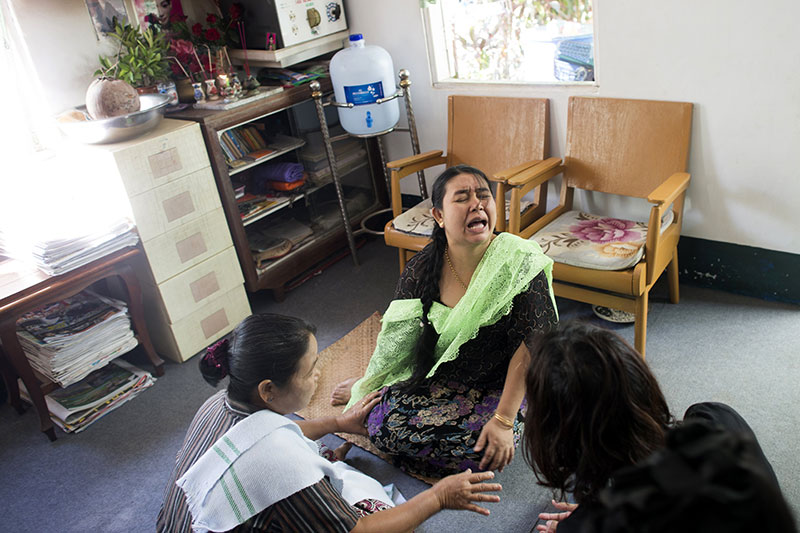
This photo taken on February 6, 2017 shows part-time medium Win Win Aye (C) being possessed in her house on the outskirts of Yangon. Photo: Ye Aung Thu/AFP
From spells to win back an errant lover to help communing with the spirits, Myanmar's mediums, soothsayers and wizards dabbling in the occult, are in high demand.
Most people here believe in a brand of Buddhism laced with animism and magic, but since the end of military rule such practices have burst into the open.
Win Win Aye is a part-time medium, who claims she has cured dozens of people of illnesses and curses -- with the assistance of benevolent Buddhist spirits.
"I know when they have possessed me," the 42-year-old tells AFP at her house in Thalyin, near Yangon, shortly after a session, which she conducts for free as a hobby.
"When I want to say something my mouth can't form the words, the person who possesses me says what he or she wants," she explains.
During the British colonial era and the half-century of military rule that followed many people used 'weikza' -- semi-divine Buddhist wizard-saints -- to fight their oppressors.
Most of these sects were disbanded or pushed underground by the generals who seized power in 1962, deeply superstitious themselves they lived in fear of a supernatural strike back.
General Ne Win, who was prime minister in the 1950s and 1960s, was said to be particularly obsessed with the occult: he reportedly bathed in dolphins' blood believing it would help him regain his youth.
In the 1980s he almost ruined Myanmar's economy by changing bank notes to denominations of his lucky number -- nine.
But since the 2011 handover of power by the junta, magic is back in the open for ordinary people.
Sorcery courses are popping up across the country, and many so-called experts are sharing their knowledge of witchcraft in journals and online.
"Ever since the Burmese censor board was dissolved (in 2012) there has been an explosion in these kinds of magical manuals," says Thomas Patton, an expert on Southeast Asian magical practices at Hong Kong's City University.
"I would argue they are one of, if not the most, widely-read genres in Myanmar," he adds.
- Masters of magic -
In an unassuming apartment in northwest Yangon, Linn Nhyo Taryar wraps a straw figurine with black tape and places it in the centre of a circle adorned with magical symbols.
The skinny 21-year-old closes his eyes and mutters incantations to 'activate' the doll in readiness for his first class as a magic teacher.
The soft-spoken sorcerer started studying magic aged five, beginning by reading tarot cards then gradually building up an online following on Facebook.
"Magic is the art of receiving the power of nature. Without the power of nature, we can't do anything," he explains.
"In magic, it depends if you want to do good things or bad things: if you do a bad thing, it will be black magic. If you do a good thing, then it will be white magic."
Minutes later more than a dozen students start crowding into the room, eager to learn arts they hope will safeguard their loved ones -- and their wallets.
Linn Nhyo Taryar shows them how to create voodoo dolls, draw magical charts and cast spells using rituals involving bananas and incense.
"I want to be able to help and protect my family with magic if something (bad) happens to us," says student Paing Soe Naung, 25.
May Sandar Kyi, a 49-year-old merchant, adds: "I am very interested in it because others treat me unfairly, like when they don't give me back (money) they take from me."
- Dark arts -
But while magical practices are increasingly tolerated in Myanmar, some still fear the power of the supernatural.
A week after AFP attended the lesson, Linn Nhyo Taryar was arrested after scared social media users told police he was teaching people how to use black magic.
Belief in sorcery can also have tragic consequences.
In October, a self-proclaimed exorcist beat two toddlers and an eight-month-old baby to death in a village outside Yangon after telling their families they were possessed.
Appearing at court the following month the alleged killer, Tun Naing, told reporters he had been taken over by a "dark spirit" at the time.
Zaw Min, a master from the popular sect of Shwe Yin Kyaw, says only people of "good virtue" should carry out exorcisms.
"We have no right to attack others," the 50-year-old tells AFP. "If we break this rule, we will be in trouble."
Still, Patton says many people believe magic was behind the biggest change in Myanmar for a generation: the end of military rule and the election of Nobel Prize winner Aung San Suu Kyi's NLD party in 2015.
"People always looked to these magical saints or wizards or sorcerers to help them bring peace and democracy," he says.
"Now that has happened a lot of these people believe that 'wow, this magic really does work.'"
© AFP


